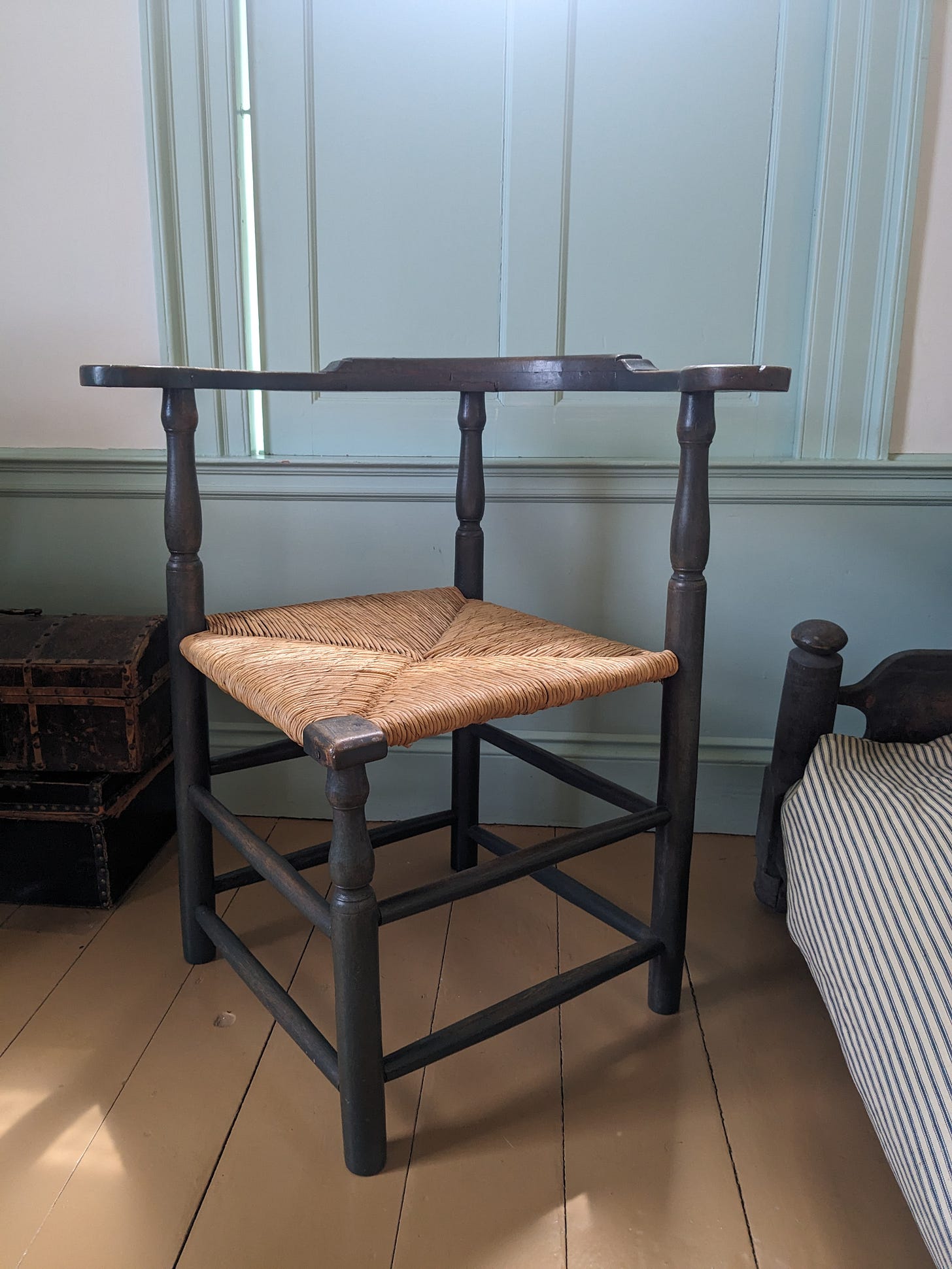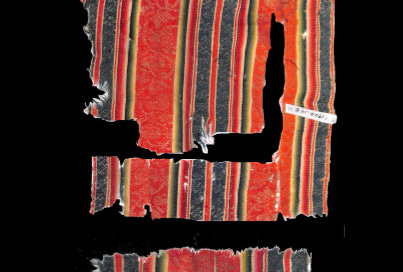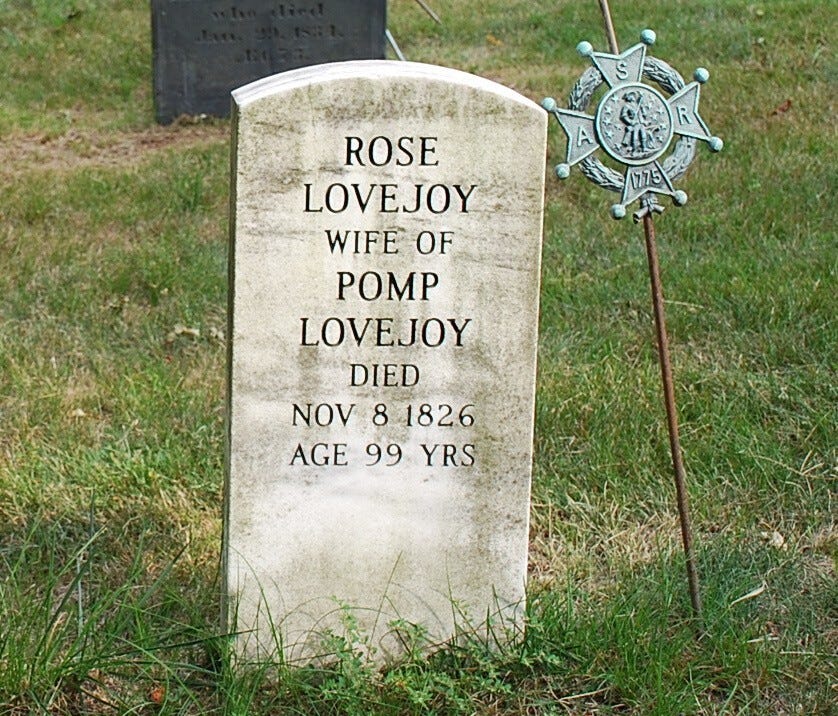Finding Rose Lovejoy's story
Four pieces of cloth are all that remain of her story of slavery and freedom
Welcome or welcome back to History Buzz! If you’re a subscriber to the Buzz, thank you! If you’re new here, or you haven’t become a subscriber yet, hit that subscribe button to have History Buzz delivered directly to your inbox. If you can, please consider a paid subscription to support the research and writing that make History Buzz possible.
As an enslaved woman, no one gathered and saved Rose Foster Lovejoy’s story. All that remains are four pieces of fabric said to be from her wedding dress. These simple pieces of cloth raise many questions. Questions we hope will be answered some day.
So little is known about her life.
Rose was born into slavery in 1727. She was brought captive to Andover by John Foster, and in 1751 she married Pompey Lovejoy who was enslaved by Captain William Lovejoy.
Following John Foster’s death, Rose was willed to his wife. She continued in her slave condition until Massachusetts abolished slavery in 1783. Rose and Pompey lived by what is known as Pomp's Pond. They ran a bake cart with cake, beef, beer, and other items on election days.
The Lovejoys appear in official records, but next to nothing remains of their physical presence. A few objects in the History Center’s collection are believed to have belonged to Rose and Pompey Lovejoy.
Rose Lovejoy’s wedding dress
Long before white wedding dresses became the norm, brides were married wearing their best dress. With its vibrant colors, this linsey-woolsey could have been a best dress worn for a wedding.
We may never know for certain if it was Rose Lovejoy's. These three pieces of fabric are said to be pieces of Rose Lovejoy’s wedding dress.
Each fabric piece is from the same piece of striped linsey-woolsey fabric. Each was donated to the History Center by a different person, in a different decade.
In 1924, two pieces were donated by the estate of Mary Ballard.
In 1936, another was donated by Alice Carey Jenkins.
In 1945, yet another piece was donated by Dr. Edward D. Lovejoy.
Why was a piece of clothing, said to be the wedding dress of a formerly enslaved woman, saved, cut up, and given to so many people?
There’s a strong connection to Andover’s South Church.
The church, originally known as the South Parish Church, was founded in 1711, so the church and its members are part of the deep history of Andover.
Mary Ballard and Alice Jenkins were both members of South Church, where Rose and Pompey Lovejoy are buried. Was the dress divided and shared among South Church members?
A family legacy of slavery
Each family – Ballard, Jenkins, and Lovejoy – was descended from Andover s earliest English settlers. Each family also had a history of holding enslaved people captive. Edward Lovejoy, who donated the last piece in 1945, was descended from the brother of the man who bought and enslaved Rose’s husband Pompey Lovejoy.
Tyring to right past wrongs?
By the early 1800s, however, members of each family were ardent abolitionists who were, perhaps, dealing with their own family’s history with slavery. During this time period, we see local public actions taken honor formerly enslaved people. Tombstones were placed. Positive stories were written.
Rose Lovejoy's tombstone was erected in the South Church Burial Ground in the late 19th century.
Could saving pieces of Rose Lovejoy’s dress, along with the tombstone, have been a way of publicly affirming this change?
Rose wasn’t the only family member whose belongings were said to be saved the passed down through families.

Legend has that this corner chair in the History Center’s collection was made by and belonged to Pompey Lovejoy. A June 1977 letter from Minerva Russell, the daughter of the owner of the chair, reveals what she knew about its history.
I wish I could be more helpful about the history of the corner chair that we always called “Pompey’s chair,” but there’s very little that I can tell you. It always stood in the front hall of my father’s house at 16 Summer St., and in the usual manner of children I took it for granted – it was just Always There. I did ask once who Pompey was, and my father told me he was a slave . . . but how my father came by it I don’t know.
. . . It was at 16 Summer St. as far back as I can remember – 1910 or so – til after the death of my father’s second wife in 1952, when I gave it to Mrs. Weeks [who gave the chair to the History Center in 1977).
Sincerely,
Minerva S. Russell (Mrs. John B. Russell)
So many questions
New questions arise all the time. One way to look at this is that the questions keep the stories alive. I recently came across this piece on the site Making History.
All people are living histories – which is why History matters1
Historians are often asked: what is the use or relevance of studying History? Why on earth does it matter what happened long ago? The answer is that History is inescapable. It studies the past and the legacies of the past in the present. Far from being a 'dead' subject, it connects things through time and encourages its students to take a long view of such connections.
So understanding the linkages between past and present is absolutely basic for a good understanding of the condition of being human. That, in a nutshell, is why History matters. It is not just 'useful', it is essential.
The highlights are mine: “History is inescapable” and “abolutely basic for a good understanding of the condition of being human.” That’s why I enjoy my work so much.
Thanks for reading! I love to hear from our readers, so please leave a comment. If you’re not yet a subscriber (free or paid) please consider signing up today to have the Buzz delivered to your inbox whenever we post.
~Elaine







Rose's and Pompey's story needs to be told. I am glad that the history center has these objects. The lack of a definitive link to Rose or Pompey is part of the story.
Great story, Elaine. Is Pomp's Pond named after Pompey?